What to do for free in Arequipa?
Arequipa is one of the most touristic cities in Peru. The historic center of the city is home to some of the most visited tourist attractions. Many of them are free for all the public. To get to know them, you only need to walk and enjoy their history, architecture and enchanting landscapes. Learn about some of the free destinations of the ‘white city’, its location, history and more.
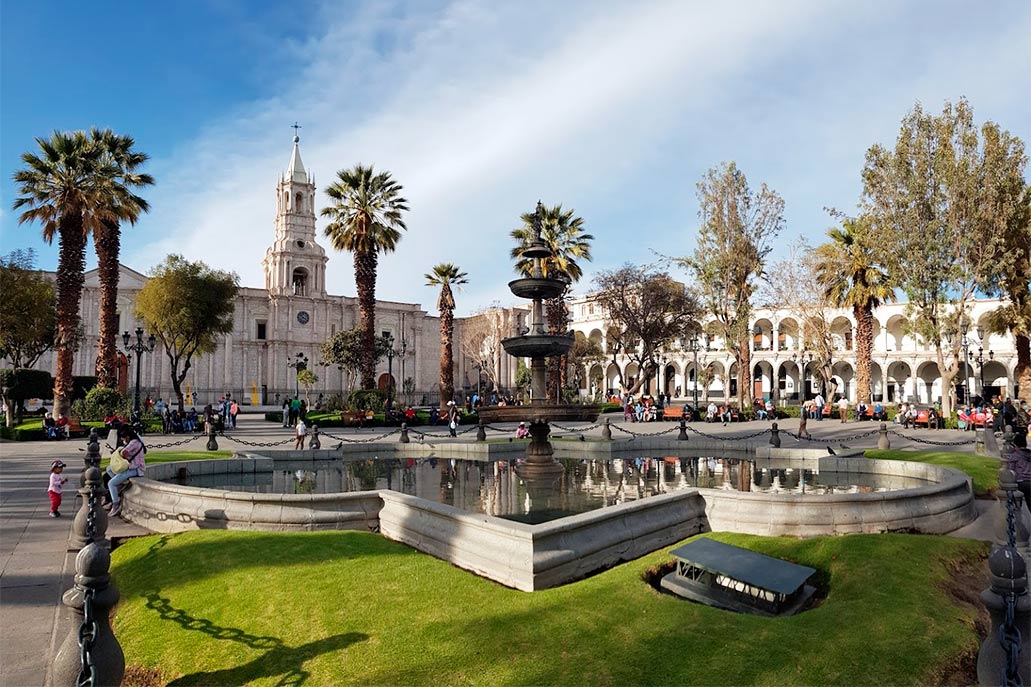
Content
The market of San Camilo
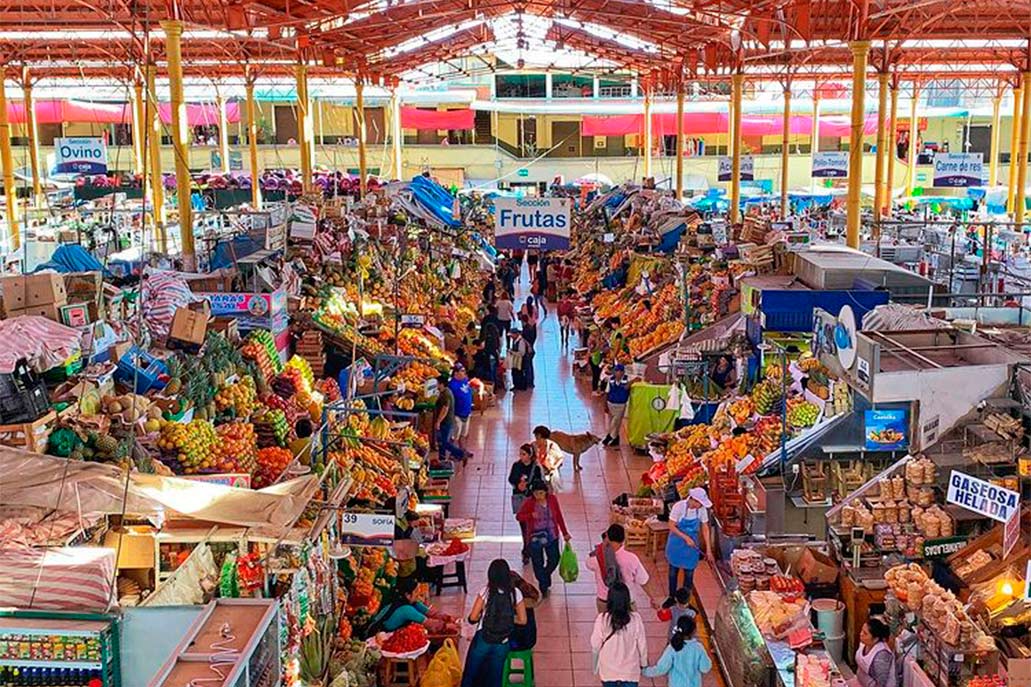
This popular market is the oldest and most diverse from the city of Arequipa. Its history dates back to the devastating earthquake of 1868 that destroyed the church of San Camilo. Since then, the place served as a school and military hospital until the construction of the food market began in 1938, the largest in the city until then.
The market offers a wide variety of products such as fruits, vegetables, dairy products, meats, utensils and even handicrafts. Until today the sculptures of the Señor del Perdón, San Pedro and San Camilo stand. Every July 14 this image of the saint is paraded through the streets of the city until it returns to the market.
The market is visited daily by both locals and Peruvian and foreign tourists. In addition to serving as a food center, the market offers a cultural experience by showing the customs and traditions of Arequipa, such as its delicious cuisine.
- Location: Calle San Camilo (just 700 meters from the Main Square).
- Visiting hours: From 6 in the morning to 8 at night.
- Optional costs: Menus cost approximately 10 Peruvian soles.
The viewpoint of Yanahuara
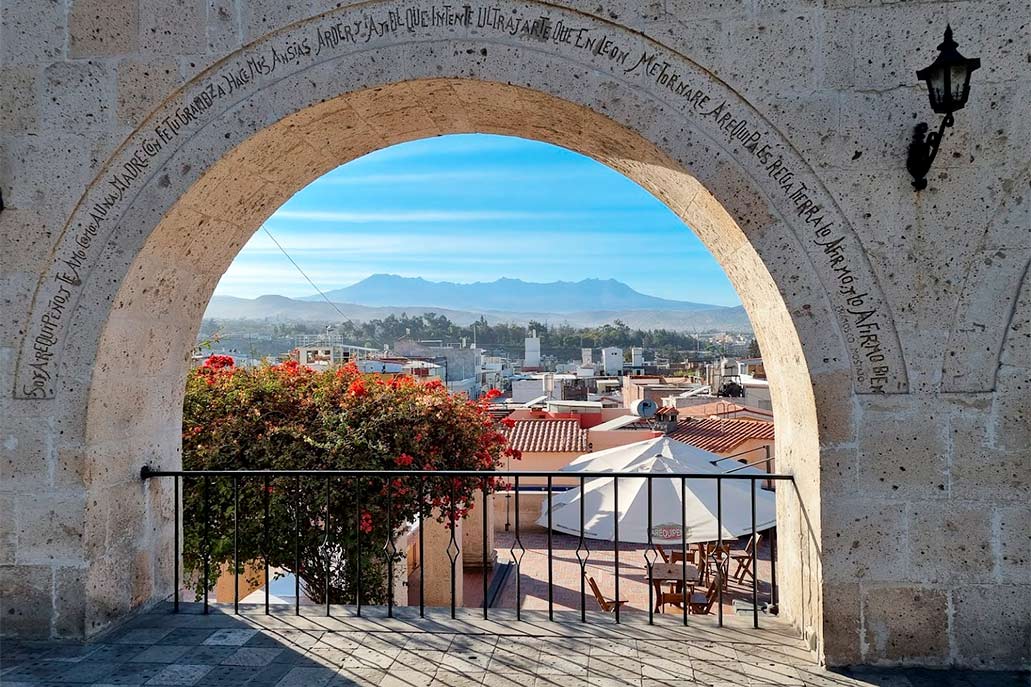
The Yanahuara viewpoint offers one of the best views of the famous Misti volcano, a symbol of the city of Arequipa. It is one of the most photographed places by visitors. In addition to the ‘Misti’, you can see the Chachani and Pichu Pichu volcanoes. Although most people visit it within a ‘City tour’, it is also possible to do it on your own, at no cost.
The construction of the viewpoint dates from the 19th century. It is a construction made up of several arches made of the famous volcanic ashlar stone. On its facade are engraved quotes from famous people in the history of Peru. It owes its name to the fact that it is located in the traditional neighborhood of Yanahuara, a few steps from the city center.
Currently the viewpoint is visited by hundreds of tourists. Around it there are tourist services such as cafes, restaurants and even lodgings. The visit is free for all the public. The photo there is a ‘must’ on the trip to Arequipa.
- Location: Miguel Grau Street, Yanahuara (about 2 kilometers from the Main Square).
- Visiting hours: Open all day.
- Optional costs: The modern glass viewpoint of Yanahuara has a cost of 35 soles for Peruvians and 50 soles for foreigners.
The Main Square of Arequipa
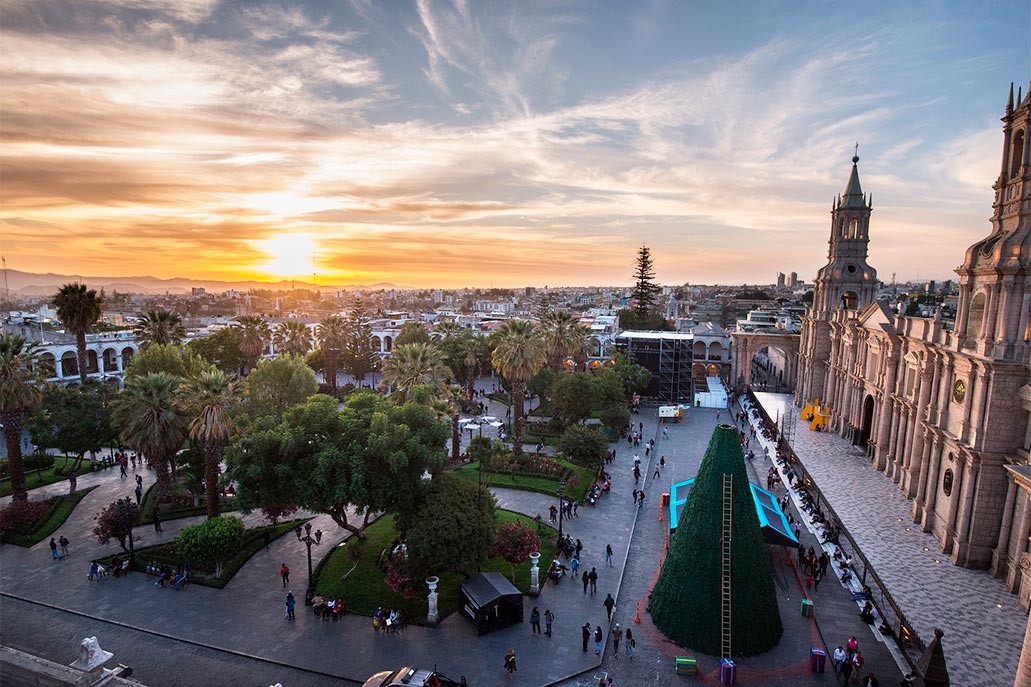
Arequipa’s main square is one of the most beautiful and spacious in all of Peru. Its history dates back to the very foundation of the city, on August 15, 1540. From there planning and construction began. The continuous remodeling as a result of the strong earthquakes caused some aspects of the square to change until it achieved its current form at the end of the 20th century.
The center of Arequipa tourism is in its wide square with side arches, its water fountain with the famous ‘turututu’ as well as its leafy trees. In front of the beautiful and imposing rise the Cathedral. Nearby are craft shops, cafes, restaurants and more.
The square is guarded 24 hours a day. Celebrations are held there for the anniversary of the city (August 15), Arequipa’s carnivals (on Sundays in February), Holy Week and more. The majority of tourist lodgings are in the historical center of the city. That is, very close to the square.
- Location: Main square, historical center of Arequipa s/n.
- Visiting hours: Open all day.
- Optional costs: The tour of the square and other tourist attractions in a ‘City tour’ costs approximately 60 Peruvian soles.
The Cathedral
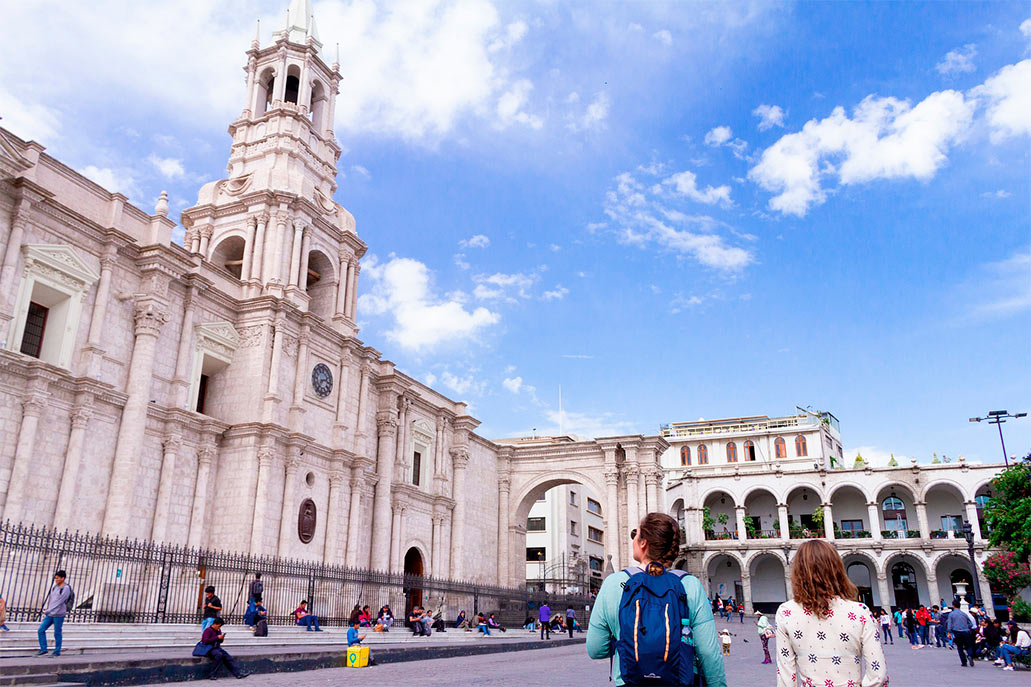
After the foundation of Arequipa in 1540, the Spanish ordered the construction of religious temples that would impose the Christian religion in the city. Of all these temples, without a doubt, the most impressive is the Cathedral, located just in front of the Main Square. It is one of the most visited and photographed architectural monuments in the ‘White City’.
Its construction begins at the end of the 16th century. However, due to the strong earthquakes that occurred over four centuries, its structures had to be modified to adopt its current form in the mid-twentieth century. It currently has a Renaissance architecture made up of three naves whose three façades have up to 70 Corinthian columns.
Inside the Cathedral pieces of art and liturgical objects of great historical and economic value are exhibited as they are made with precious stones. The Cathedral is considered a World Heritage Site by UNESCO as it is part of the historic center of the city. It is made of ashlar, the most famous volcanic stone in Arequipa.
- Location: Main square, historical center of Arequipa s/n.
- Visiting hours: Open all day.
- Optional costs: The entrance to the museum of the Basilica of the Cathedral costs 10 Peruvian soles.
The Church of the Company of Jesus
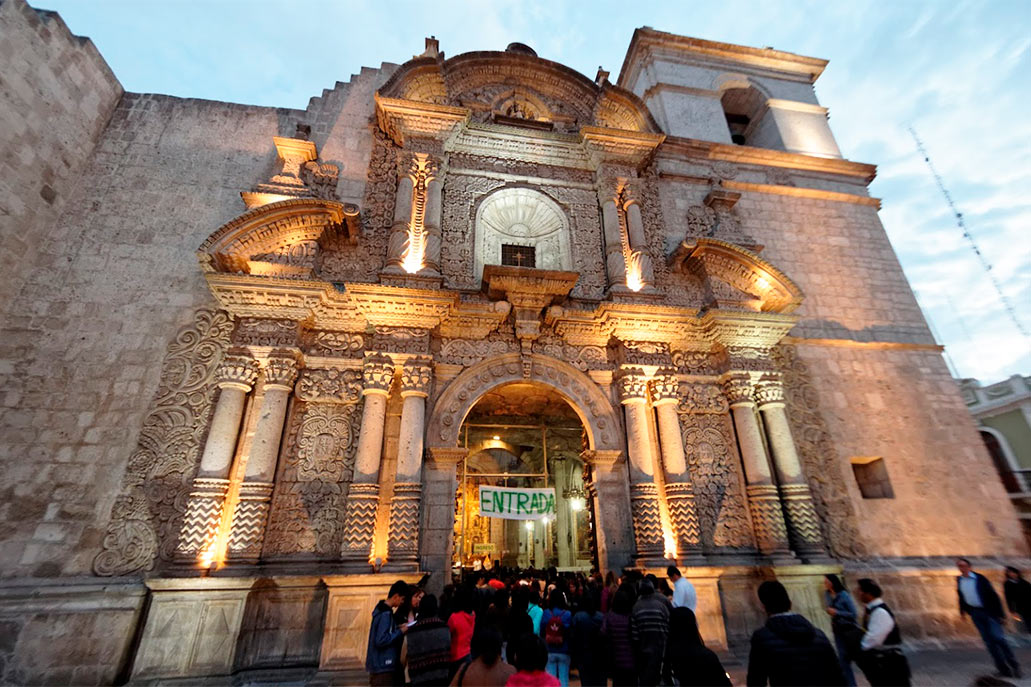
In the historic center of Cusco, in one of the corners of the Main Square, stands tall and historic the church of the Jesuit order. This building dates from the end of the 16th century. Its architecture presents a baroque style in which its beautiful facade with reliefs of animals, plants and figures of Christianity stands out. The temple is also made with the famous ashlar stone.
The interior of the church also houses some of the remarkable Baroque works of art such as: the main pulpit, the set of three altarpieces, dozens of canvases from the so-called ‘Cusco school of painting’ and other utensils used in the liturgy decorated with precious stones.
Although the church can be visited through the so-called ‘City Tour Arequipa’, many visitors can do it on their own. Due to its architectural beauty and its historical importance, it is a very photographed place by tourists.
- Location: Calle General Morán 114 (corner of the Main Square in Arequipa).
- Visiting hours: Open during liturgy hours (7 am).
- Optional costs: The entrance to the museum of the Basilica of the Cathedral costs 20 Peruvian soles.
The neighborhood of San Lazaro
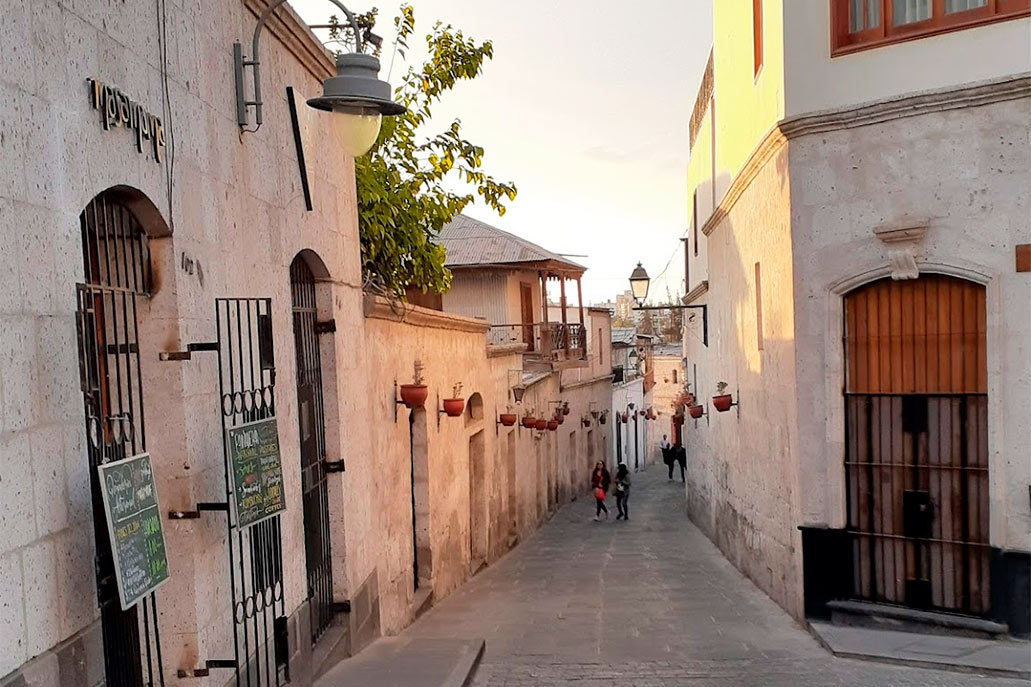
The San Lázaro neighborhood is the first street in the city. It has an antiquity even before the founding of the city in 1540. Its enclosures are made with ashlar. The small streets and alleys that make up this famous neighborhood are: Violín, Cristales, Ripacha, Desaguadero, Combate Naval, Calienes and Bayonetas.
Among the oldest constructions of the place, the chapel of San Lázaro stands out. At the beginning of the 17th century, the neighborhood was the home of important personalities of the Spanish colony. Today it is an area protected by the National Institute of Culture (INC) that declared it ‘Monumental Urban Environment’.
The visit to this historic place is totally free for everyone. Some tourists prefer to go on the Arequipa City Tour. One of its most famous attractions is its bread called ‘Ripacha’, like one of its alleys. Some of the other traditional neighborhoods of the ‘White City’ are: the Yanahuara neighborhood, the Cayma neighborhood, the Selva Alegre neighborhood and the Vallecito neighborhood.
- Location: Just 850 meters from the Main Square. It is on the banks of the Chili River (between Jerusalem, Juan de la Torre and Grau Bridge streets).
- Visiting hours: Open all day.
- Optional costs: ‘Ripacha’ bread can be purchased in the San Lázaro neighborhood for only 1 Peruvian sol.
By Machupicchu Terra – Last updated, August 28, 2023